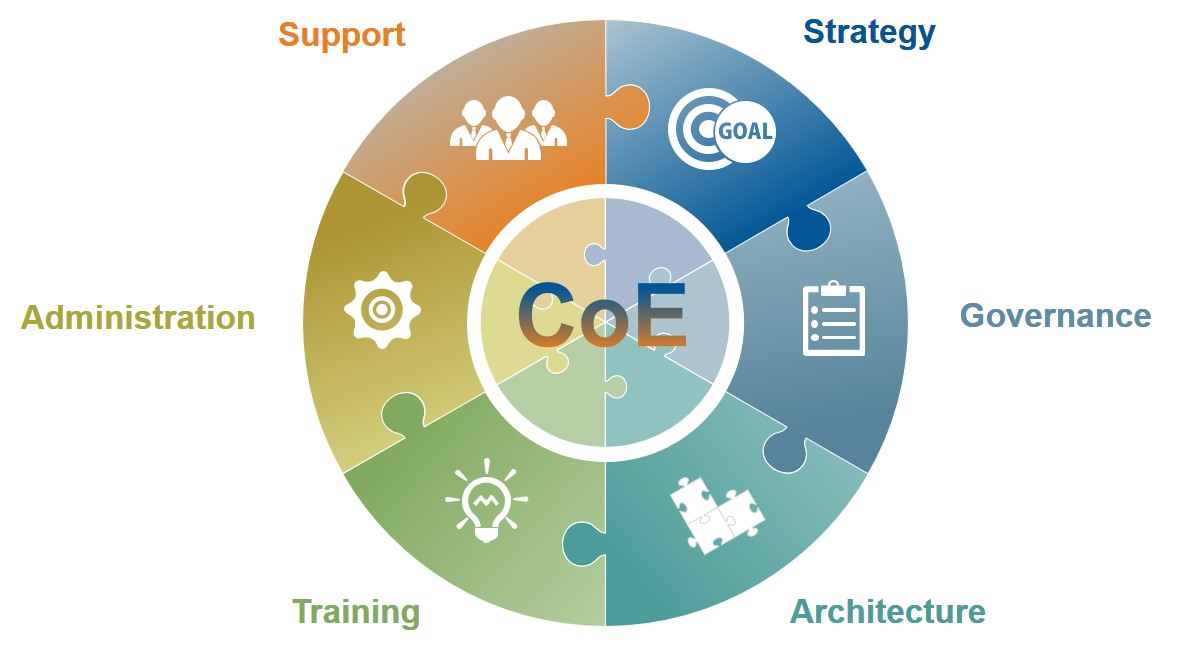Center of Excellence
An Alternative Approach: How to Achieve Success with an Office 365 Center of Excellence

The future is digital. Every company, irrespective of industry, is, or will soon be, thinking and operating like a digital company, re-engineering operations to support the new speed of business. If you’ve invested in Office 365, you have the capability to execute your own digital transformation. Enabling and sustaining that capability, however, can be challenging for even the largest organizations.
Just maintaining deep knowledge on the entire platform and understanding the implications of each tool and every enhancement on your environment alone can be daunting. It’s why taking the “if you build it they will come” approach to Office 365 is simply destined for failure.
That’s why we developed an alternative, managed approach – the Office 365 Center of Excellence. We approach digital transformation as a process, instead of a project. Our proven methodology is made up of six pillars which we’ll explore in this blog post and will show how you can achieve the maximum success of your Office 365 investment with a Center of Excellence approach.
What is a Center of Excellence?
The Center of Excellence is a proven process methodology that provides solutions beyond standard managed services by utilizing six services areas to improve and execute on digital transformation in Office 365 and SharePoint. Through this process, Office 365 becomes an extremely powerful business productivity solution that if used and supported correctly, can greatly improve innovation, deliver business value, protect your internal and external data, decrease reliance on email, and further empower your employees.
Six Pillars of a Successful Office 365 Center of Excellence
The power of the Center of Excellence (CoE) comes from combining the right skills, activities, and commitment and focusing them on your organization’s goals. There are six service areas that require focus for a successful Office 365 CoE, and communication is their underlying foundation. Let’s take a look at each service area:
- Strategy
Strategy is critical to success because it forces your organization to define what you need instead of expecting the technology to solve problems that have not been thoroughly defined. Strategic efforts focus heavily on asking stakeholders what problems must be solved and defining the value derived by meeting the goals. Developing a strategy first allows you to measure success in a tangible way to ensure you meet your objectives. In addition, when employees understand why they are being asked to do something, they generally respond more favorably when they know the vision of the project. - Governance
Governance takes Strategy down to the service level. Governance efforts define usage policies, guidelines, and rules for your solutions. A successful plan leverages Microsoft’s best practices, demonstrates how to use different services to meet the business objectives, and ensures there is ownership of critical requirements and processes.
Governance is critical because it requires that other parts of the business are engaged to ensure success. One of the most important aspects of governance is gaining traction with a group of stakeholders that will take ownership of the digital transformation process. And governance doesn’t stop — it requires regular meetings to discuss progress, collect feedback, and make changes to the governance plan, roadmap, and service offerings as technology and business needs change. - Architecture
Architecture focuses on the technical components of leveraging Office 365, including information architecture, taxonomy, metadata, branding, user experience, best practices, technology changes, application integration, and the continuous effort to ensure that all the pieces fit together correctly for your organization. - Training
Training isn’t one size fits all. It’s customized training in small doses on a regular basis in order to increase user understanding and adoption. Custom training combined with repetition increases user interaction and sends a message to the end users that your organization cares enough to ensure users have what they need to be effective.
- Administration
Administration components in Office 365 are different from classic on-premises platforms. The needs of patching, service packs, upgrades, and most of the routine maintenance activities are gone. However, many of those requirements have been replaced with new features and capabilities that should not be ignored. A successfully engaged administration plan will involve monitoring Microsoft messaging relating to tenant updates, changes, and outages. It’s not uncommon to see 15 or more messages per week relating to items affecting each Office 365 environment. - Support
Support includes defined service level agreements based on requirements of the business. If your organization needs 24×7, one-hour response time because it’s critical to the business objectives, then this must be considered. CoE resources must have deep understanding of the platform and capabilities. While no single person understands it all, it’s imperative that your organization’s support skills align with its intended use of Office 365. With user adoption, including from your support teams, this will grow organically. While all the service areas are important, this is the area to absolutely ensure the proper resources are in place. Most customer contact, feedback, and ideas are generated through support interaction. Proper support teams will have plans to collect feedback and present this information to the governance and architecture teams to continue the circle of improvement.
The Importance of Process
The real CoE magic happens when you have the right combination of pillars driven by a defined and ongoing process, supported by the right resources for each set of activities, all of which are set with the proper cadence.
Your CoE is like a puzzle. All your components should fit together to showcase your vision with a total solution.
Without some pillars (or pieces of the puzzle), you will find there will be a hole in your process. Depending on the size of your organization, the needs and complexity of the solution will vary, but all are necessary to a certain degree.
When your entire plan is working harmoniously, it demonstrates to the organization the capability of IT to deliver on the needs of the business. This builds internal trust, while spotlighting IT as a leader and innovator in your organization, versus positioning IT as a cost center. This is key to transform your internal end users’ impressions of IT of simply providing tools and services to one where IT provides full life-cycle solutions to business problems.
A Customer-Centric Approach
The difficulty with digital transformation is that it is 100% based on people and their ability and willingness to change how they operate. When all of the pillars of the CoE are executed and maintained, user adoption will increase. As adoption increases, the entire solution becomes self-sustaining.
There is a tipping point where existing users create most of the new demand for capabilities because of their reliance on these tools. Your CoE activities drive user adoption, which in turn, support your overall transformation efforts. You should see a few of these benefits across your organization as overall user adoption grows:
- Cultural shift from manual processes to automated technologies
- Increased efficiency from a work processing perspective
- Decreased reliance on email
- Streamlined communication, searchable communication
With a Center of Excellence approach, you will begin to see an increase in user awareness, engagement, adoption, and all of the measurable and tangible benefits of true digital transformation.

